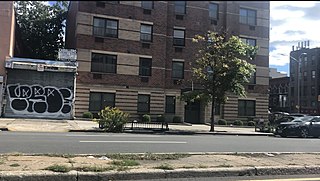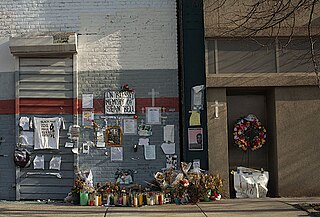"American Skin " is a song written by Bruce Springsteen, inspired by the police shooting death of Amadou Diallo by NYPD. It premiered, unreleased, during the E Street Band's 1999–2000 reunion tour in concert in Atlanta on June 4, 2000, the final concert before the tour's final ten-show run at New York City's Madison Square Garden, where it was predicted to featured again.
The New York Police Department's Street Crime Unit is a plainclothes anti-crime unit. The SCU was formed in 1971 as the "City Wide Anti-Crime Unit" and operated for decades tasked with the apprehension of armed felons from the streets of New York City. The unit returned with its original name in 2015 after being disbanded for 13 years, then disbanded again in 2020 along with the rest of the anti-crime teams.
James J. Fyfe was an American criminologist, a leading authority on the police use of force and police accountability, and a police administrator.

Crime rates in New York City have been recorded since at least the 1800s. The highest crime totals were recorded in the late 1980s and early 1990s as the crack epidemic surged, and then declined continuously since the mid-1990s and throughout the 2000s. As of 2023, New York City has significantly lower rates of violent crime than many other large cities. Its 2022 homicide rate of 6.0 per 100,000 residents compares favorably to the rate in the United States as a whole and to rates in much more violent cities such as St. Louis and New Orleans.
Ousmane Zongo was a Burkinabé arts trader living in the United States who was shot and killed by Brian Conroy, a New York City Police Department officer during a warehouse raid on May 22, 2003. Zongo was not armed. Conroy did not receive any jail time but was convicted of criminally negligent homicide, received probation, and lost his job as a police officer.

Anthony H. Gair was an American attorney and advocate. He was a partner of the law firm Gair, Gair, Conason, Rubinowitz, Bloom, Hershenhorn, Steigman & Mackauf, which was founded by his parents in 1945. He looks for cases that are in the public interest. Notably, he represented the family of Amadou Diallo in a case that spurred reform of the New York City Police Department.

Rubén Díaz Jr. is an American politician who served as the 13th borough president of The Bronx in New York City from 2009 to 2021. He was elected in April 2009 and reelected in 2013 and 2017. He previously served in the New York State Assembly.
A contagious shooting is a sociological phenomenon observed in police personnel, in which one person firing on a target can induce others to begin shooting without knowing why they are firing. The term may have been coined, but certainly rose to prominence in public discourse in the aftermath of the killing of Amadou Diallo by the NYPD in 1999.

Sean Bell, an unarmed African American, was shot and killed by undercover New York City Police Department (NYPD) officers in the borough of Queens on November 25, 2006. Bell and two of his friends were shot when both plainclothes and undercover NYPD officers fired a total of 50 rounds. Bell's friends, Trent Benefield and Joseph Guzman, were severely wounded. The incident sparked fierce criticism of the New York City Police Department from members of the public and drew comparisons to the 1999 killing of Amadou Diallo. Three of the five detectives involved in the shooting went to trial on charges of first- and second-degree manslaughter, first- and second-degree assault, and second-degree reckless endangerment; they were found not guilty.

Throughout the history of the New York City Police Department, numerous instances of corruption, misconduct, and other allegations of such, have occurred. Over 12,000 cases have resulted in lawsuit settlements totaling over $400 million during a five-year period ending in 2014. In 2019, misconduct lawsuits cost the taxpayer $68,688,423, a 76 percent increase over the previous year, including about $10 million paid out to two exonerated individuals who had been falsely convicted and imprisoned.
Akai Gurley, a 28-year-old black man, was fatally shot on November 20, 2014, in Brooklyn, New York City, United States, by a New York City Police Department officer. Two police officers, patrolling stairwells in the New York City Housing Authority (NYCHA)'s Louis H. Pink Houses in East New York, Brooklyn, entered a pitch-dark, unlit stairwell. Officer Peter Liang, 27, had his firearm drawn. Gurley and his girlfriend entered the seventh-floor stairwell, fourteen steps below them. Liang fired his weapon; the shot ricocheted off a wall and fatally struck Gurley in the chest. A jury convicted Liang of manslaughter, which a court later reduced to criminally negligent homicide.

On December 20, 2014, Ismaaiyl Abdullah Brinsley shot and killed Rafael Ramos and Wenjian Liu — two on-duty New York City Police Department (NYPD) officers — in the Bedford–Stuyvesant neighborhood of Brooklyn. Brinsley then fled into the New York City Subway, where he killed himself. Earlier in the day, before he killed Ramos and Liu, Brinsley had shot and wounded his ex-girlfriend Shaneka Thompson in Baltimore after initially pointing the gun at his own head.

The killing of Ramarley Graham took place in the borough of the Bronx in New York City on February 2, 2012. Richard Haste, a New York Police Department officer, shot Graham in the bathroom of the latter's apartment. The 18-year-old Graham was in possession of marijuana when Officer Haste tried to stop him on the street. Graham fled to his grandmother’s house, and went into the bathroom to flush the marijuana. Officer Haste forced his way into the building, kicked down the front door and then broke down the bathroom where he shot Ramarley Graham to death. Haste could be seen on surveillance cameras smiling and laughing with the responding officers and detectives—the same men who would later testify they had told Haste that Graham had a gun. Haste claimed to believe Graham had been reaching for a gun in his waistband, but no weapon was recovered.

Talib Kweli Greene is an American rapper. He earned recognition through his collaboration with fellow Brooklyn rapper Mos Def in 1997, when they formed the group Black Star. Kweli's musical career continued with solo success including collaborations with producers and rappers Kanye West, Just Blaze, and Pharrell Williams. In 2011, Kweli founded his own record label, Javotti Media.
The shooting of Anthony Hill, a U.S. Air Force veteran, occurred on March 9, 2015, in Chamblee, Georgia, near Atlanta. Hill, fatally shot by police officer Robert Olsen, suffered from mental illness and was naked and unarmed at the time of the incident. The incident was covered in local and national press and sparked the involvement of Black Lives Matter and other advocacy groups who demonstrated their anger at the shooting. In January 2016, a grand jury indicted officer Olsen on two counts of felony murder and one count of aggravated assault. Nearing the fourth anniversary of the homicide, it was decided that Olsen's trial would be rescheduled for September 23, 2019, with delays including three successive judges having recused themselves in the case.
On April 29, 2017, Jordan Edwards, a 15-year-old African-American boy, was murdered by police officer Roy Oliver in Balch Springs, Texas, within the Dallas-Fort Worth metroplex. Edwards was shot in the back of the head while riding in the front passenger's seat of a vehicle driving away from officers that attempted to stop it. He was unarmed during the encounter.








